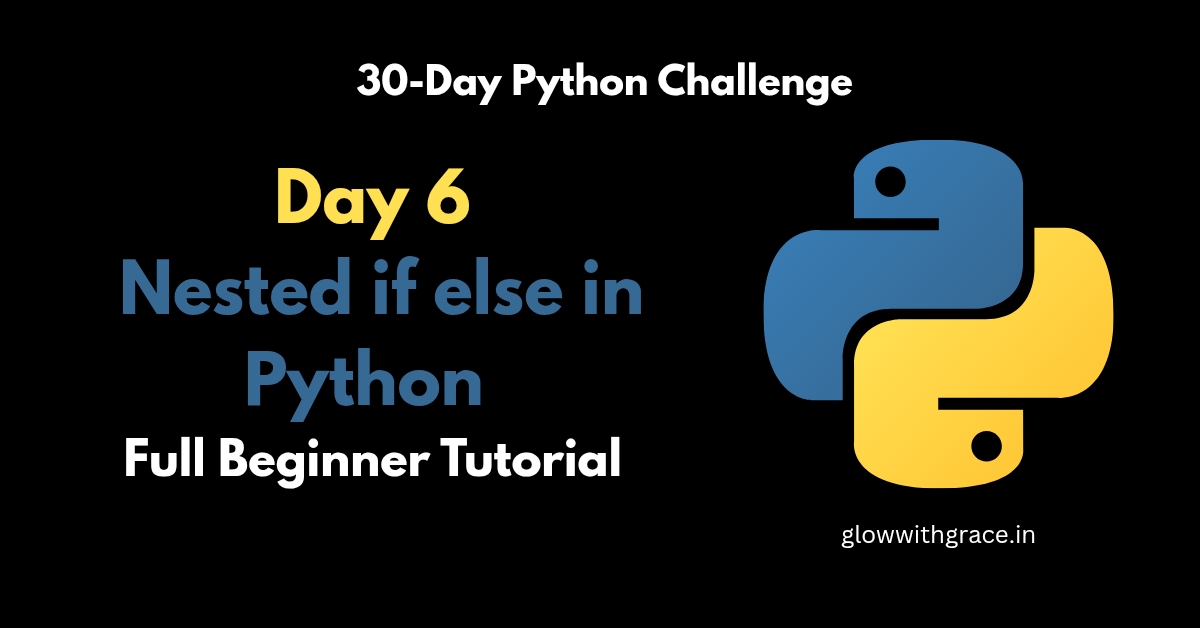Hey coder buddy! Welcome to Day 6 You’ve already mastered if else statements yesterday How to Use Python If Else Statement – Full Beginner Tutorial Day 5 🎉 That’s a big milestone. But guess what? Python takes it a step further with something called nested if else. Sounds complicated? Don’t worry it’s actually super fun once you get the hang of it.
In today’s post, we’ll dive into nested if else in Python with simple examples, common mistakes beginners make, and mini-coding exercises to test your skills. Let’s level up together
What Is Nested If Else in Python?
Nested if else means putting one if (or else) statement inside another. Think of it like decision-making inside a decision like multiple layers of checking.
Imagine this:You walk into a café. If it’s open, you check if your favorite pastry is available. If it’s not, you go for coffee. That’s nested logic and that’s exactly what Python lets you do.
Here’s a basic syntax:
if condition1:
if condition2:
# do something
else:
# do something else
else:
# outer else block
Example: The Bakery Test
Let’s visualize this with a bakery logic 🧁
bakery_open = True
favorite_pastry = "Croissant"
if bakery_open:
if favorite_pastry == "Croissant":
print("Yay! I’ll take one croissant, please.")
else:
print("Hmm... I’ll try something else today.")
else:
print("Oh no! The bakery is closed.")
Pretty cool, right? It’s just like how you make choices in real life. Python is helping your computer make similar smart decisions.
Mini Exercise: Age Checker with Nested If
Let’s write a program to check if someone is eligible to vote and drive.
age = int(input("Enter your age: "))
if age >= 18:
if age >= 21:
print("You can vote and drive!")
else:
print("You can vote, but not drive.")
else:
print("You are too young to vote or drive.")Common Mistakes Beginners Make with Nested If Else
Wrong indentation – Python depends on proper spacing.
Too many nested levels – If it’s more than 2–3 levels deep, consider using elif or functions.
Forgetting else blocks – Always think about the “what if not” scenario.
Pro Tips to Master Nested If Else in Python
1. Think like a flowchart – break problems into layers.
2. Indent properly – use 4 spaces or a tab, but be consistent!
3. Use comments – it helps you (and others) understand the flow.
Practice Challenge: The Login Checker
Try building a login checker:
username = input("Enter username: ")
password = input("Enter password: ")
if username == "student":
if password == "python123":
print("Access Granted!")
else:
print("Incorrect Password.")
else:
print("Username not found.")Try changing the values to test different outcomes 🔐
Bonus: Should You Use Nested If Else in Real Projects?
Nested ifs are great for small, simple decisions. But in big apps, they can get messy. For more complex logic, Python gives us other cool stuff like elif, functions, or even dictionaries. But for now nested if else in Python is a great tool to have in your pocket!
Recap – What You Learned Today:
What is a nested if else in Python
Real-world examples
How to use it in simple programs
Mistakes to avoid
A small coding challenge
What’s Coming on Day 7?
Tomorrow, we’ll explore elif statements which makes decision-making even smoother. You’ll love how Python gives you more control with fewer lines of code!
Stay curious, keep coding💙
Wanna Explore More? Try C Programming Too!
If you’re enjoying this Python journey, I’ve got something else you’ll love.
Did you know that C programming is the backbone of many modern languages (including Python itself)? It’s a powerful way to boost your logic, understand memory better, and become a stronger programmer overall.
I’ve already started a 30 Days of C Programming series just like this Python one! It’s beginner-friendly and packed with examples
How to Start C Programming in 2025 – Day 1 Beginner’s Setup Guide and start exploring another amazing language!
Who knows? Learning C alongside Python might just turn you into a code wizard.
Frequently Asked Questions (FAQ)
What is a nested if else statement in Python?
A nested if else statement is when you place one if or else condition inside another if or else block. It allows your code to make more complex decisions based on multiple conditions.
When should I use nested if else in Python?
You should use nested if else when you need to check multiple levels of conditions, especially when decisions depend on prior checks. It’s useful in login systems, grading logic, and menu-based applications.
Are nested if else statements bad practice?
Not necessarily. They’re fine for simple logic. However, too much nesting can make code hard to read. For complex scenarios, consider using elif, functions, or switch-case-like structures (e.g., match in Python 3.10+).
Can I use elif instead of nested if?
Yes, in many cases elif simplifies code readability. However, if your logic needs checking inside an already true condition, nesting is required.
